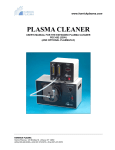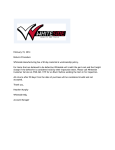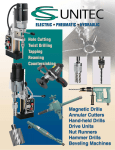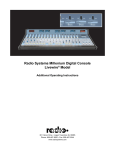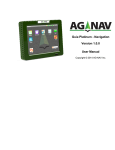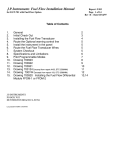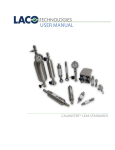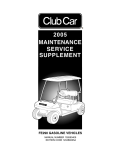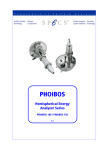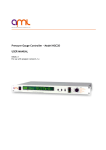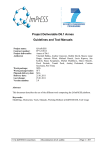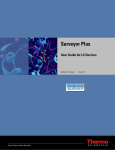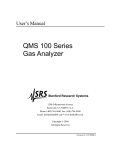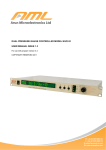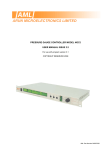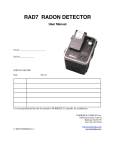Download Manual - Stanford Research Systems
Transcript
User’s Manual Process Pressure Reduction System 1290-D Reamwood Ave. Sunnyvale, CA 94089 408-744-9040 · 408-744-9049 fax [email protected] · www.thinkSRS.com Version 1 ( 20-Jul-01 ) Warranty This Stanford Research Systems product is warranted against defects in materials and workmanship for a period of one (1) year from the date of shipment. Service For warranty service or repair, this product must be returned to a Stanford Research Systems authorized service facility. Some components may be serviceable directly from the supplier. Contact Stanford Research Systems or an authorized representative before returning this product for repair. Trademarks ® ® Ultra-Torr and VCR are registered trademarks of Swagelok Co. Tygon® is a registered trademark of Norton Co. All other brand and product names mentioned herein are used for identification purposes only, and are trademarks or registered trademarks of the respective holders. Information in this document is subject to change without notice. Copyright © Stanford Research Systems, Inc., 1996. All rights reserved. Stanford Research Systems, Inc. 1290-D Reamwood Avenue Sunnyvale, California 94089 408 744 9040 Printed in USA iii Table of Contents Table of Contents.......................................................................................................................... iii Safety.............................................................................................................................................. iv Installation Check List ................................................................................................................... v Parts Needed to Install .................................................................................................................. v Fast Start........................................................................................................................................ vi Specifications ............................................................................................................................... vii Materials List ............................................................................................................................... viii Calibration Log.............................................................................................................................. ix 1. Introduction ................................................................................................................................ 1 2. Installation .................................................................................................................................. 2 3. Operation .................................................................................................................................... 3 A. Startup .................................................................................................................................................3 B. Measuring at Medium Vacuum............................................................................................................4 C. Measuring at High Vacuum .................................................................................................................4 D. Idle ......................................................................................................................................................4 E. Shutdown .............................................................................................................................................5 F. Overpressure ........................................................................................................................................5 4. Measurement Techniques ......................................................................................................... 6 A. Operating at Pressures Other Than the Design Point...........................................................................6 B. Correcting for the Chamber Background.............................................................................................6 C. Calibration ...........................................................................................................................................7 5. Care & Maintenance................................................................................................................. 10 A. Turbo Pump.......................................................................................................................................10 B. Diaphragm Pump ...............................................................................................................................10 C. Bake-out ............................................................................................................................................11 D. Operation with Condensable Gases ...................................................................................................12 E. Leak Testing ......................................................................................................................................12 F. Replacement Parts..............................................................................................................................13 6. Design Principles ..................................................................................................................... 14 A. Aperture Selection .............................................................................................................................14 B. Response Time ..................................................................................................................................15 C. Operation at Ultra-high Vacuum........................................................................................................18 7. Troubleshooting....................................................................................................................... 19 SRS PPR System iv Safety Line Voltage The PPR system is specified for power line of either 110 V / 60 Hz or 220 V / 50 Hz. The diaphragm pump will only operate on the specified voltage. Operating at other voltages will damage the motor. The turbo pump controller is factory preset for the specified voltage; refer to the controller manual for information about changing the line voltage. The SRS RGA power supply has a universal input which automatically detects the power line voltage, but requires different fuses for 110 or 220 V operation. For 110 V operation use one 2 A fuse. For 220 V operation, two 1 A fuses must be used in the power entry module. The SRS RGA power supply is configured at the factory for one of these options. Exhaust As shipped, this system exhausts to the atmosphere. If the PPR system is attached to a vacuum chamber that contains hazardous gases, the user must make provisions to handle the exhaust from the diaphragm pump. Ventilation Do not block the air inlet to the cooling fan of the RGA. Components will fail without this cooling. The PPR system requires forced air cooling to operate at a reasonable temperature. Although the pumps can operate without forced air cooling, they will do so at a high temperature. Place fans near the pump bodies to lower their operating temperature and extend their life. Elastomer Seals Silicone has been reported to react adversely and irreversibly with the glass contained in an electron multiplier. In systems containing an RGA w/electron multiplier, do not use silicone greases or oils on seals; use only hydrocarbon based materials. SRS PPR System v Installation Check List Your PPR system is shipped assembled. Only a few electrical connections and the turbo pump foreline connection need to be done once the system is installed. The system is shipped with the following parts: • • • • • the assembled inlet (valves, turbo pump body, and RGA if ordered) turbo pump controller, and power cord diaphragm pump, and attached power cord KF16 clamp and o-ring this manual, and manufacturer’s manual for turbo pump and controller if RGA ordered • RGA (attached to system) • RGA software and serial port cable • RGA manual Parts Needed to Install • • • one copper gasket for 2 3/4 CF flange high strength nuts & bolts for the 2 3/4 CF flange and wrenches (recommended) a second person to hold the inlet during installation SRS PPR System vi Fast Start • Attach the PPR system to an available 2 3/4 CF flange. • Attach the electronic control unit (ECU) to the RGA probe. Match the hole pattern in the ECU with the two alignment rods on the probe and push the ECU. The electrical connections should be easy to make. If the ECU does not slide easily onto the RGA probe, back off and try slightly rotating the ECU. Once the ECU has been attached, turn the two knobs on the back of the ECU to secure the ECU to the probe. • Connect the hose from the diaphragm pump to the turbo pump body with the included KF16 clamp and o-ring. • Connect the cable between the turbo pump controller and pump body, and connect the power cord. The controller display should show “READY FOR LOCAL SOFT START” • Close both valves to isolate the RGA chamber. The small valve is a 1/4 turn valve that is closed when the handle is perpendicular to the small tube. • Plug in the diaphragm pump to start roughing the RGA chamber. • Press the start button on the turbo pump controller. There is no need to wait until the RGA chamber has reached rough vacuum. Both the diaphragm pump and turbo pump can be started at the same time. • The turbo pump will reach full speed in about 8 minutes. The controller display will show “Normal operation” when the pump has reached speed • Connect the power cord to the RGA power supply and turn on the power switch. • Connect the serial cable between the RGA and an available COM port on the computer (typically COM2). • Install the RGA software on the computer by inserting the first disk and executing the SETUP program. • Start the RGA program. Under the Utilities menu, choose “RS232 Setup...”. In the dialog box that appears, choose the COM Port that the RGA is connected to and then press the “Connect” button. After a short initialization, the RGA is ready. To confirm communications, under the “Head” menu choose “Get Head Info...”. A box will appear showing information about the RGA. • Click the filament button ( ) on the toolbar to activate the ionizer. Click the GO button on the tool bar and a scan will begin from 1 to 50 amu. • During initial operation monitor the operating temperature of the pumps to be sure that they are sufficiently cooled. They should only be warm to the touch. SRS PPR System vii Specifications Performance Gas flow ∼ 3 ×€10−5 mbar l s-1 ( = P V& ) with pressure reduction inlet active Response time 20 s at 1 mbar inlet pressure (scales linearly with pressure) Startup time 8 minutes standard Connections Inlet 2 3/4 inch CF flange, rotatable with through holes Inlet to controller 6 foot cable (provided) Inlet to backing pump 6 foot 1/4 ID × 7/16 OD flexible hose (provided) Computer RS-232C, 28,800 baud, 9 pin D connector Power 3 pin grounded cables Pumps High Vacuum hybrid turbomolecular/drag pump, 70 liter/s, ultimate pressure 2 × 10-9 mbar Backing diaphragm pump with ultimate pressure less than 1 mbar protection class IP44 Cooling requires forced air cooling General Power requirement either 110 V / 60 Hz or 220 V / 50 Hz (not field selectable) less than 300 W total Dimensions vary with configuration Weight inlet (mounted on chamber) diaphragm pump controller 7 kg (16 lbs) 7.5 kg (16.5 lbs) 7 kg (16 lbs) SRS PPR System viii Materials List SRS receives many requests for information about corrosion compatibility. It is our policy not to state the compatibility of our system with various corrosive environments. We simply cannot test the myriad combinations of environments that our customers use. We do provide a list of all the materials exposed to the gas being introduced into the system. Our expectation is that users who need to measure corrosive environments already have some type of system that creates, handles and contains the corrosive gases. Given that they have designed and operate said system, they are the best people to decide the compatibility of the materials in our system with the specific corrosive environment. The PPR system contains the following materials: Body • • • • • • • 304 stainless steel - high vacuum tube 316 stainless steel - quarter inch tube and fittings molybdenum - electrical feedthrough ceramic - electrical feedthrough AgCuIn - braze material on feedthroughs alumina - contained in the RGA aluminum - body of diaphragm pump Replaceable Components • • • glass - if an electron multiplier is installed in the RGA chromium - surface of the electron multiplier IrO2·ThO2 - filament of RGA Seals • • • • • • • • • • copper - seals in the CF high vacuum flanges 316SS - major component of VCR® seals silver - a thin layer on the VCR® seals to prevent gauling Viton - o-ring seal in the KF flange buna-N - seal in the high conductivity valve Kel-F - seal in the isolation valve TFE/316SS - body seal in the isolation valve neoprene - diaphragms in diaphragm pump nitrile butyl rubber(NBR) - diaphragm pump valves Tygon® - connections to diaphragm pump (can be substituted) SRS PPR System ix Calibration Log SRS serial number ___________ In the table below are the results of the factory calibration. The factor is entered in the pressure reduction factor dialog box (under the Utilities menu) in the RGA software. Although the RGA software will store the value for you, a written record is recommended. performed by date test gas P high side P low side factor FACTORY SRS PPR System Introduction 1. 1 Introduction RGA’s can only operate in vacuum at pressures below 10-4 mbar. The PPR system allows the RGA to analyze gases in vacuum systems that operate above 10-4 mbar. The system contains two inlet paths that provide a high conductivity path and a low conductivity path. The high conductivity path is used when the user’s vacuum system is at pressures below 10-4 mbar. At high vacuum, typical applications are leak testing and monitoring the ultimate vacuum of the chamber. The low conductivity path is used when the user’s vacuum chamber is at pressures above 10-4 mbar. This path contains an aperture that reduces the pressure several decades to a level suitable for the RGA. Different apertures are used depending on the pressure in the users vacuum system. A pair of pumps are required to draw the gas through the aperture to the RGA. The pump group used is a hybrid turbo-molecular/drag pump (referred to as turbo pump) and a high performance diaphragm pump. The use of these pumps results in a compact and completely oil-free system. There is no danger that improper operation of the PPR system will contaminate the user’s vacuum system. This manual is an addendum to the full RGA manual and discusses the PPR system and aspects of the RGA unique to the PPR system. This manual assumes the reader has general familiarity with RGA’s; those who do not should read the RGA manual first. All users should read the “Operation” and “Measurement Techniques” sections describes situations specific to the PPR system. The RGA manual contains an appendix which discusses additional measurement techniques. The PPR system requires little maintenance; the section on “Care & Maintenance” describes what is required. Users are referred to the full RGA manual for details of the RGA, its maintenance, and programming. The PPR system is offered in many geometries, one of which is shown in Figure 1. The system consists of three main groups: the inlet, a small chamber formed by the tee, and the pump group. The components shown in Figure 1 are attached to a flange on the user’s vacuum system. Also contained in the system are a controller for the turbo pump and a diaphragm pump, both of which can be placed up to 1 meter away. hi-C valve RGA sample valve bypass loop turbo pump Figure 1. Inlet system components. SRS PPR System 2 Installation 2. Installation Check to make sure you have received all of the parts of the system. The system attaches to an available 2 3/4 CF flange on you vacuum system. The CF flanges can support the weight of the system, but it is necessary to use high strength bolts. High strength bolts are typically sold by vacuum hardware suppliers. Do not use standard 1/4-28 bolts or other substitutes. The system is shipped in a clean state and is ready to attach with no preparation. Installation is much easier if a second person is available to hold the system while you tighten the bolts. Once the system is attached, make the electrical connections from the turbo pump to its controller and connect the power cord to the controller. Connect the diaphragm pump to the turbo pump with the KF16 o-ring and clamp. The oring does not need grease. Inspect both faces of the KF flanges for dirt or scratches. If they are clean, place the o-ring assembly between the two flanges and place the clamp around the flanges. Tighten the clamp. Connect the cable from the RGA to the computer, and the power cord to the RGA. The system is now ready to operate. The RGA manual contains a section describing installation and use of the software. The CF flange can support the weight of the PPR system. Because the system is a significant lever arm, be wary of placing the system where it is likely to be bumped into by people or equipment. During initial operation, monitor the operating temperature of the pumps to make sure they are receiving sufficient cooling. Under average conditions, only small fans are required to cool the pumps. They should operate warm to the touch (35°C or lower). If the pumps are hot, they will require additional cooling. SRS PPR System Operation 3. 3 Operation Figure 2 shows a schematic of the inlet system. The system has two routes to the RGA which are controlled by a high conductivity (hi-C) valve and the small sample valve. The pressure in the main vacuum system determines which valves are opened. The hi-C valve is opened by turning counter-clockwise for several turns. The sample valve is a 1/4 turn valve. It is opened by turning counter-clockwise until the mechanical stop is reached. The handle provides a positive indication of whether the valve is opened or closed; it is closed when the handle is perpendicular to the tube. Hi-C Valve Main Chamber RGA Aperture Hybrid Turbo Pump Sample Valve Diaphragm Pump Exhaust Figure 2. Flow schematic of the PPR system A. Startup Prepare by closing both valves on the inlet. Next, start both pumps. There is no need to wait between starting the diaphragm pump and turbo pump; simply start them both at the same time. After a few minutes the turbo pump will have reached full speed as indicated on the controller. It should show “NORMAL OPERATION”. By default the turbo pump is programmed to reach full speed in 8 minutes. The startup time can be changed to shorter or longer values if needed. The controller manual discusses how to change this value. Once the system is at speed, either of the two inlets can be opened, depending on the pressure in the main vacuum system. SRS PPR System 4 Operation The turbo pump controller tracks various data on the pump. Pressing the “PUMP CURRENT, TEMPERATURE, POWER” button displays these value and the rotation speed in the display window. The temperature is measured in the pump at the bearings and will be 30 - 35 °C with good cooling. The “CYCLE NUMBER, CYCLE TIME, PUMP LIFE” button displays history data about the pump. The cycle number is the count of the times the pump has been started. The time to the right of “CYCLE” shows the duration of the current cycle. The time to the right of “PUMP LIFE” show the cumulative time the pump has been operated. The historical data is remembered by the controller even when the unit is not connected to line power. B. Measuring at Medium Vacuum When the system is up to speed, it is ready to make measurements. When the main vacuum system is at medium vacuum ( > 10-4 mbar), measurements are made by opening the sample valve. (Presumably the hi-C valve is already closed; otherwise, the turbo pump would not be operating.) When the sample valve is first opened, there is a small volume of high pressure gas trapped between the aperture and valve that is suddenly released into the turbo pump. The pump will slow momentarily and then recover. Measurement can now be made with the RGA software. To make the RGA software account for the pressure reduction occurring across the aperture, choose the “Pressure Reduction...” item under the “Utilities” menu. In the dialog box which appears enter the pressure reduction factor (from the calibration sheet) and check the “Enable” box. All the partial and total pressure values are now multiplied by this value. This is only a scaling operation; the data from the RGA software is valid with or without the pressure reduction factor enabled. When the sample valve is not open, the pressure reduction factor can be disabled by un-checking the “Enable” box. The pressure reduction factor is saved with the RGA files, so once the value has been entered, the user need only check or uncheck the enable box to activate the scaling. The button provides quick access to the dialog box. C. Measuring at High Vacuum Measurements at high vacuum are made by opening the hi-C valve. There is no need to close the sample valve. The low conductivity of the bypass loop will cause it to have no effect on the measurements. Also, if the sample valve is closed, it is possible that a small volume of high pressure gas is trapped between the aperture and valve seat. This trapped volume will bleed out slowly through the aperture and may interfere with the measurements. By leaving the sample valve open, this possibility is eliminated. If the pressure reduction factor was enabled, disable it now. D. Idle If measurements are made with the system every day, the system can be kept running 24 hours a day and idled when not in use. Only for long periods of down-time is it recommended to turn off the system. When the main vacuum chamber is not being measured for short periods, e.g. several hours, shut both valves. This state allows the SRS PPR System Operation 5 turbo pump to continue pumping on the interior surfaces of the system, thereby reducing the background. Also, with the system isolated, the load on the pumps is decreased. The system is immediately available to begin measurements from this state by opening either of the valves. For longer periods, e.g. overnight or weekends, the RGA filament can be turned off to extend its life. The turbo pump can be set to spin at half its nominal rate by pressing the “LOW SPEED” button on the controller. This idle state places the lowest load on the RGA and pumps, but the system is not immediately available to make measurements. To restore the system, press the “LOW SPEED” button a second time and activate the RGA filaments. The system will be ready in a few minutes. E. Shutdown To shutdown the system, close both valves and turn off both pumps. The turbo pump is stopped by pressing the “START,STOP,RESET” button; there is no need to unplug the controller. After several minutes, the turbo pump will coast to a stop. The diaphragm pump should not be stored under vacuum for long periods. Because of this, different procedures are recommended when the system is shutdown for short or long periods. For short periods simply turn off both pumps. For shutdown periods longer than about 15 minutes, it is advisable to vent the system. Venting is accomplished by opening the vent valve on the body of the turbo pump. If the diaphragm pump is stored under vacuum for extended periods, the pressures internally will reach a state that prevents the pump from starting. When this happens the diaphragm pump will not start. This locked state is cured by venting the system; the diaphragm pump will then start up. Storage under vacuum also temporarily degrades the ultimate pressure of the diaphragm pump. Once the pump is operating, the performance will return over several hours. F. Overpressure If the user forgets to close the hi-C valve as the main vacuum system transitions from low pressure to high pressure, the pressure in the RGA will increase to undesirable levels. Above about 10-4 mbar, the RGA and turbo pump cannot operate. The RGA has a protection check that will shut off the filament if the pressure in the chamber is too high. The turbo pump will loose speed as the pressure increases. When it operates at high pressure it will generate more heat than it can dissipate. This situation will lead to an over-temperature error at the bearings, which will shut off the pump. Both of these protection measures must not to be relied on to shut off the RGA and turbo pump. They only provide some defense against serious damage to the equipment. SRS PPR System 6 Measurement Techniques 4. Measurement Techniques In general, the PPR system only scales the pressure and does not change the function of the RGA. The techniques discussed in the main manual and other texts about RGA’s are applicable to this system. The following sections discuss issues unique to the use of the RGA in the PPR system. A. Operating at Pressures Other Than the Design Point Each system is specified for one inlet pressure, the design point. The aperture is chosen to reduce the inlet pressure from the design point to about 5×10-6 mbar at the RGA. As the inlet pressure increases or decreases from the design point, the pressure at the RGA will vary proportionally. The RGA will operate well to pressures of 1×10-5 mbar and will operate with loss of linearity to 1×10-4 mbar; above which it will turn off. Based on these values, the inlet pressure can increase about 1 decade above the design point. The ultimate vacuum of the PPR system is 2 × 10-9 mbar. The ultimate vacuum causes a background spectrum on which the sample spectrum is superimposed. Thereby at the design point, the ratio of sample to background is 1000:1. As the inlet pressure drops, the sample to background ratio drops. The background is spectrally unique, i.e. not broadband, and will present different problems to different users. For example, measurements of an argon environment containing helium will not be strongly effected by the background of water, nitrogen, and oxygen. But, if the measurements where looking for trace oxygen and water, the sample to background ratio must be kept high. Thereby, the inlet pressure can decrease 2 decades or more below the design point, as long as the user is aware of the degradation of the sample to background ratio. B. Correcting for the Chamber Background Even with the sample flow and hi-C valves closed, their will be a noticeable background in the mass spectrum. This background in the RGA chamber is caused by outgassing from the surfaces, backstreaming through the turbomolecular pump, and gas production from the ionizer of the RGA. These three processes account for the ever present background of hydrogen, water, nitrogen, oxygen, and carbon dioxide seen in high vacuum. The outgassing of water can be minimized by extensive pumping with both valves closed; typically the system should achieve water partial pressures around 1 × 10-8 mbar. The other two process (backstreaming and ionizer) are fundamental and cannot be reduced. The ultimate vacuum of the turbo pump causes nitrogen to be present at no lower than 2 × 10-9 mbar and oxygen at 1/4 of that level. Carbon dioxide from the ionizer will be present at levels from 10-9 to 10-7. The RGA software contains a background subtraction feature that allows the chamber background to be removed from the mass spectrum. The background spectrum is correctly measured with both valves closed. To obtain a background subtracted spectrum, follow these steps: SRS PPR System Measurement Techniques 7 1) Measure one analog or histogram with both valves closed. If the RGA is scanning continuously, you can select “Stop at End” from the “Scan” menu. The data displayed must be a complete scan, and be measured with the same parameters as the scans to follow. 2) Under the Utilities menu, select “Background” and select “Scan Data Background” from the dialog box. Check the box next to “Enable” and select “OK” to close the dialog box. This makes the current spectrum the background and all spectra displayed subsequently will have this spectrum subtracted from it. 3) Open either the sample flow valve or the hi-C valve and start the scans. The displayed spectra are the background corrected result. The ability to subtract background is limited by signal proportional noise, which is typically present at between 1-10% of the signal magnitude. Because this noise originates in the ionizer of the QMS, subtraction can only remove 90% of the background. This limits the ability to see small changes of less than 1% at the same masses as the background. C. Calibration Reduction Factor Calibration is not necessary on a frequent interval. Two calibration factors are used in the PPR system: the standard RGA sensitivity and one additional factor, the pressure reduction factor. Determination of these factors requires comparing the RGA with a known-accurate pressure gauge and calculating a factor that makes the two agree. The RGA is calibrated at the factory for partial pressure of nitrogen and the pressure reduction factor was measured for nitrogen using a capacitance manometer. The RGA sensitivity is stored in the ECU unit; the aperture factor is included in the 9.0E+05 test report. The RGA sensitivity will age in the same manner as high vacuum ion 8.0E+05 gauges and may need periodic recalibration. The aperture is stable, but its performance varies slightly with the 7.0E+05 pressure at the inlet and the gas composition at the inlet. A typical 6.0E+05 performance curve is shown in Figure 3. If your measurements need high precision to account for this slight difference, the 5.0E+05 pinhole must be calibrated at the exact 0 5 10 15 pressure the main system operates. Also, Pressure high side (mbar) you can recalibrate the pinhole to account for gases with different transport Figure 3. An example of aperture performance at properties. e.g. helium. In general though, difference pressures. as long as the aperture has not physically changed, e.g. plugged, or corroded, the pressure reduction factor will not need recalibration. Procedures for calibration of these factors is described in the sections SRS PPR System 8 Measurement Techniques below. The type of gauges available on the main vacuum system determine the type of calibration that can be performed. The RGA intrinsically measures an ion current, which is proportional to partial pressure. The partial pressures reported by the RGA software are calculated by the formula: Pi = pressure reduction factor × sensitivity factor (Torr/A) × ion current (A) To determine both the factors, the RGA sensitivity must be calibrated first. Once the sensitivity factor is calibrated, the pressure reduction factor can be calibrated. The RGA sensitivity factor is set using the “Utilities|Sensitivity Tuning...” menu item in the RGA software. The use of this feature is fully described in the section “RGA software, Head Calibration & Security” in the main manual. The user should read that section before proceeding below. Calibrating the Sensitivity Factor Method 1 The most accurate method of calibrating the RGA sensitivity requires removing just the RGA from the PPR system and attaching it to a calibration test stand. The test stand should ensure that the RGA and reference gauge are exposed to the same effective pumping speed and test gas throughput. Once the RGA is calibrated, it can be returned to the PPR system. While the sensitivity factor determined by this calibration is accurate, the results may not be what is expected. When the RGA is back in the PPR system, it will not agree with a gauge located in the main vacuum system. This is because the two instrument are exposed to different pumping speeds and gas throughputs; they should disagree. The RGA software contains a scaling factor that allows the values reported by the RGA to agree with system gauges. The scaling factor is present for all the software modes and is limited to values near 1 (0.01 to 100) and is intended for correcting for systematic differences without adjusting the accurate sensitivity factor stored in the RGA ECU. The scaling factor is very useful if the RGA is moved from system to system. Instead of recalibrating the sensitivity factor, a different scaling factor can be used for each system. The scaling factors are stored in the .RGA files used by the software. Method 2 If the goal of “calibration” is to make the RGA agree with another gauge in the main system, a practical solution is to align the RGA with that gauge. By “align” we mean that the RGA and main system gauge will show the same numbers, but the RGA is not strictly accurate. To align the RGA with an ion gauge in the same system, open the hi-C valve on the PPR. Leak a calibration gas into the main vacuum system, so that the composition is largely one species and so that the pressure is between 7 × 10-8 and 7 × 10-5 mbar. Use the RGA software to calibrate the sensitivity factor using the main system ion gauge’s reading as the reference value. The sensitivity factor calculated by the software will be the product of the accurate sensitivity factor times a factor that accounts for the different effective pumping speed that the two gauges are exposed to. SRS PPR System Measurement Techniques 9 Method 3 Some systems may not have a high vacuum gauge, as assumed in the method above, but instead only a medium vacuum gauge, e.g. capacitance manometer, Pirani, or thermocouple. The RGA software allows the sensitivity factor to be calibrated with the pressure reduction inlet in use and thereby allows the RGA to be aligned with the system gauge. First, setup the system for making measurements at medium vacuum as discussed above. Make the pressure in the main chamber such that the pressure at the RGA ionizer is between 7 × 10-8 and 7 × 10-5 mbar. For example if the pressure reduction factor is 1 × 105, then the main system pressure must be between 0.007 and 7 mbar. Make sure to enable the pressure reduction factor and then calibrate as usual. In the sensitivity dialog box, enter the reading of the main system gauge in the Reference Pressure edit box (the value must be in Torr). Typically, an ion gauge reading would be entered in the Reference box, but with the Pressure Reduction factor enabled, the software will allow and compensate for higher values. Next, click the “Measure” button and accept the results. When the RGA is calibrated with this method, an implicit assumption is that the pressure reduction factor is accurate. The RGA sensitivity factor is only as accurate as the pressure reduction factor. The software has no method of determining whether an accurate value was entered for the pressure reduction factor. Calibrating the Pressure Reduction Factor If the RGA sensitivity factor was calibrated by methods 1 or 2 above, the pressure reduction factor can be calibrated. Calibrating the pressure reduction factor is done by comparing the RGA reading to that of a second system gauge known to be accurate at medium vacuum pressures. Because the RGA was calibrated above, we know it is accurate and thereby can use its reading as a reference for the high vacuum pressure. If the RGA was calibrated with method 3 above, the pressure reduction factor cannot be calibrated. That method assumed the pressure reduction factor was already accurate and the procedures below would simply recalculate the same factor. To calibrate the pressure reduction factor, make a measurement through the aperture, but with the pressure reduction factor disabled in the software. Leak a calibration gas into the main chamber such that the composition is largely pure (>90%) and at the pressure you need to operate the main system. Use any software mode to obtain the partial pressure of the calibration gas (table mode is easiest). Do not use the total pressure reading; its precision is low and varies with composition. The readings of the RGA will the high vacuum values that occur at the ionizer. The reading of the system gauge provides the medium vacuum pressure reference. The new pressure reduction factor is the system pressure gauge reading divided by the RGA reading. Enter this value in the pressure reduction dialog box and check the Enable box. The RGA and system pressure gauge will now agree. This pressure reduction factor is stored in the .RGA files and is recalled when the files are reopened. SRS PPR System 10 Care & Maintenance 5. Care & Maintenance The PPR system is designed to require low maintenance. No maintenance schedule is recommended; components can be used until they fail. At such time factory service or kits are available to rebuild the system. The sections below discuss methods for diagnosing the performance of the major components of the system (the RGA is discussed in its manual). A. Turbo Pump The turbo pump is permanently lubricated. It requires no maintenance for the life of the bearings. The life of the bearings is highly dependent on the gases pumped and the environment the pump is used in. Under normal environments (high vacuum and no corrosive gases) the pump can be expected to work continuously for many years. Under higher gas loads, corrosive environments, or repeated shock forces, the life of the bearings is degraded. Bearings in the pump can be replaced by the factory. An exchange program is available that minimizes down-time by shipping an equivalent rebuilt pump immediately in exchange for the users pump. Contact SRS or your distributor for details. B. Diaphragm Pump Typically, the PPR system operates at high vacuum and places very little load on the diaphragm pump. Lifetimes of several years are possible under these conditions. Frequent start ups and shut downs increase the load on the pump and decrease the lifetime. Keeping the pump cool will also extend its operating life. The performance of the pump can be diagnosed by tracking the ultimate vacuum of the PPR system. To measure the ultimate vacuum, isolate the RGA by closing both valves. With the system isolated, measure the spectrum with attention to the nitrogen and oxygen peaks. New systems will show nitrogen at approximately 2 × 10-9 mbar and oxygen at 1/4 that value. These gases are present because air backstreams through the turbo pump. The pressure at the RGA will increase directly with the pressure at the turbo exhaust. Thereby, the ultimate vacuum at the RGA is a direct indication of the vacuum in the backing line and the performance of the diaphragm pump. As an example, a new system will have a backing line pressure of 1 mbar and at ultimate vacuum will have oxygen present at 5 × 10-10 mbar. One year later, another ultimate vacuum test might show oxygen present at 1 × 10-9 mbar. This value indicates that the backing line pressure has doubled to 2 mbar. The turbo pump can easily tolerate exhaust pressures up to 5 mbar, so the performance of the diaphragm pump is still acceptable in this example. A second indicator to track is the current drawn by the turbo pump and its operating temperature. The turbo pump works harder as the backing line pressure increases and will cause the current and temperature to increase. Operating at higher currents causes no problems as long as the turbo pump is sufficiently cooled. More aggressive cooling may be needed to operate when the diaphragm pump performance has decreased. SRS PPR System Care & Maintenance 11 Good statistical lifetime data is not currently known for diaphragm pumps. The pumps contains two components that are most likely to fail: valves and membranes. The valves tend to wear resulting increased backing line pressure (decreased compression ratio). The membranes tend to fail suddenly by tearing and result in the pump being unable to achieve usable vacuums. Kits are available that allow the pump to be serviced by the user or the pump can be returned for service. A kit of replacement seals is available from SRS or the manufacturer. If the backing pressure increases, the first check should be to remake the connection between the 1/4 inch tube and the diaphragm pump. The connections to the ends of the 1/4 inch hose can be quickly remade: • Twist the aluminum sleeve counter-clockwise to remove it from the hose barb. • Slide off the flexible hose and either cut off the end or replace the entire hose. • A thin layer amount of grease (Apiezon or other hydrocarbon based vacuum grease) can be applied on the hose barb to improve the seal. • Reattach the sleeve. When remaking the connection, wet the outside of the hose with water to ease installation of the sleeve. After re-attaching the hose, start the pumps and watch the current drawn by the turbo pump. If the current is not as low as your records indicate, the next check is to replace the o-rings at each end of the hose. The hose barb at the diaphragm pump has a BSP/ISO 1/8-28 228/1 thread, which uses an elastomer seal retained within a metal ring (Cajon part number S-2-RS-2V). Simply turn the fitting counter clockwise to remove the seal. This fitting is a face type seal and thereby does not rely on the threaded portion of the body to make a seal. The fitting has a finish that prevents gauling; Teflon tape is not required nor helpful. The smooth faces on the diaphragm pump and on the body of the hose barb must be clean and free of nicks or scratches. Before replacing the seal, wipe the faces clean with a lint free cloth which has been wetted with a minute amount of grease. Excessive force is not required when tightening the fitting to the body of the pump. The metal ring limits the compression of the elastomer seal to its ideal value. Once metal to metal contact is reached, tighten the fitting only slightly further. The o-ring sealing the backing line to the turbo pump body is unlikely to leak. In the event it is damaged, replace it with a standard o-ring for a KF16 flange (either Viton® or buna-N). Only the elastomer needs to be replaced; the metal centering ring can be reused. C. Bake-out Periodic high temperature bakeout can be used to clean the interior surfaces of the PPR system. Several components limit the highest temperature that can be safely used. · · The hi-C valve contains an Viton ® seal and is rated to 200 °C at the valve body. The plastic handle cannot tolerate this temperature. The sample valve is rated to 120 °C at the valve body. The plastic handle cannot tolerate this temperature. SRS PPR System 12 Care & Maintenance The flange of the turbo pump cannot exceed 120 °C. The bearings cannot exceed 60 °C. · The RGA cannot exceed 100 °C while operating or 250 °C if the ECU is removed. Given these, a safe strategy is to bake the entire system at 100 °C. If heating tape is used, wrap the system, stopping at the turbo pump flange and about 1 inch before the RGA ECU flange. For more aggressive bake-outs, careful control of temperature is required. A multipoint thermocouple monitor (e.g. the SR630) or temperature controllers will be necessary. Cooling the body of the turbo pump with air or water may be required to keep the flange below the 120 °C limit. If contamination is a recurring problem, constant operation at elevated temperature may be more efficient than periodic bakeouts. · D. Operation with Condensable Gases The PPR is designed for vacuum systems that nominally operate at room temperature. Under these conditions, any species that is a gas in the vacuum system can be expected to travel through the PPR system without condensing. Without a heat input, a gas will cool as it expands through a pressure reduction aperture (according to its Joule-Thompson coefficient). In the PPR system, the absolute pressure difference across the aperture is small and the flow rate is small; under these circumstances the interior metal surfaces can provide sufficient heat to the expanding gas to keep it from condensing. If problems due to condensation are suspected, the aperture and sample valve can be wrapped with heating tape to test for condensation. When the vacuum system being measured is significantly hotter than the PPR system, condensation is likely and presents a problem. If the species in the hot vacuum system are gases only at an elevated temperature, they will condense when they reach the PPR system. The condensed material will continually build up in the PPR system and cover the valve seats and aperture. Two approaches can prevent this problem: control the location of condensation or prevent condensation. The first approach can be very simple: place screens or metal plates in the inlet to provide sacrificial surfaces for condensation. The sacrificial surfaces should have good thermal connections to the outer walls. These surface will act like a trap and prevent the unwanted materials from passing. The second approach involves operating the entire PPR system above the condensation temperature of the condensable material. This may be feasible if the operating temperature is below 100 °C. The previous section lists the temperature limits of the various components. This high temperature approach is difficult, because every surface of the system must be maintained above the condensation temperature and below its temperature limit. The first approach is recommended because of its ease. E. Leak Testing The seals in the system will have a long life. The valve seat seals in the hi-C valve and sample valve will eventually require replacement. The hi-C valve seat is the most critical; a small leak could easily be equal to the amount of gas that is pumped through the aperture. If a leak across the hi-C valve seat is suspected perform this quick test. SRS PPR System Care & Maintenance 13 Start with the main chamber at high vacuum. Open both valves briefly and then close both valves tightly. Setup the RGA software to monitor the species present in the main vacuum system in the pressure vs. time mode. Next, increase the pressure in the main chamber. If the pressures on the RGA side of the valves increase, gas is leaking across the seat of one of the valves. If the rate of rise directly follows the pressure rise in the main chamber, the leak is across the hi-C valve seat. If the rise is delayed the leak is likely across the seat of the sample valve. Last, to double-check the result, pump the main chamber back down. If a valve seat was leaking, the pressure measured by the RGA will drop. Contact SRS or distributor for information about factory service and field service kits. The metal seals will last indefinitely under normal usage. The integrity of these seals can be assured using the leak testing mode of the RGA software. Helium or any other gases can be used, e.g. argon, or tetrafluoroethane. The CF flanges and VCR fittings have leak testing ports. Spray the test gas directly into these ports and look for any increase in the level measured by the RGA. Leaks should be immediately detected in this manner. Standard 2 3/4 CF and 1/4 VCR gaskets are used in the PPR system. The backing line can be visually inspected or more rigorously tested with helium. If helium leaks into the backing line, it can backstream through the turbo pump to the RGA and be detected. Setup the leak testing mode to detect helium and spray the hose fittings well. Smaller leaks can be detected by placing a bag over the fittings to produce a pure helium atmosphere around the suspect leak. This process is not as fast as with the metal seals. It can take several minutes for the helium to be detected. F. Replacement Parts Some of the parts discussed in the previous sections are widely available. For users who wish to obtain replacement parts directly, the following manufacturers part numbers will be needed. Nupro and Cajon parts are carried by your local Swagelok distributor. diaphragm pump diaphragm rebuild kit - contact SRS Sample valve entire valve - Nupro SS-DLVCR4 Kel-F stem kit - 6L-3AK-DS-KF diaphragm gasket kit - SS-3DK-DS VCR gaskets 1/4 stainless steel w/ silver coating - Cajon SS-4-VCR-2 RS gaskets BSP/ISO parallel thread, 1/8-28 - Cajon S-2-RS-2V Hose Tygon or similar, 1/4 inch ID × 7/16 inch OD SRS PPR System 14 Design Principles 6. Design Principles The PPR system has been designed to suit the general needs of users. Some users will choose to modify the system to suit unique applications. This section describes the principles of the system so that users may better understand how to make modifications. A. Aperture Selection The aperture is chosen to reduce the inlet pressure from the design point to about 5×10-6 mbar at the RGA. This value allows the RGA to operate with the inlet pressure one decade above or below the design point. Some users may specific applications which would be better suited if the RGA were operating at different pressure. The pressure at the RGA ionizer is determined by the throughput of the aperture, Q, and the effective pumping speed, Seff: P (in mbar) = Q (in mbar l s -1 ) S eff (in l s -1 ) (1 ) The effective speed at the ionizer is 30 liter s-1 . Changing the diameter of the hole in the aperture effects the throughput and thereby the operating pressure. One motivation to increase the operating pressure is to increase the signal to background ratio. Outgassing produces its own throughput that produces pressures governed by equation 1. The signal to background ratio is simply the ratio of the two throughputs. Because the background is fixed, the only route to improving this ratio is to increase the signal, i.e. aperture throughput. Examples would be measurements of water or hydrogen in the main chamber. A low pressure of water background is 2×10-8 mbar. If a pure argon atmosphere was being monitored in a typical PPR system, the pressure at the RGA would be 5×10-6 mbar. Therefore, water would be seen at 4000 ppm due to the background. To improve the detection limit for water in the argon, the aperture can be reselected such that the operating pressure was pushed near its limit, e.g. 9×10-5 mbar. The new aperture improves the detection limit of water to 220 ppm. This improvement does not occur without cost. If the inlet pressure increases slightly, the overpressure circuit of the RGA can trip and turn off the filament. The detection limit has been improved a factor of 20, but the tolerance for inlet pressure fluctuations is lost. A second motivation to modify the pinhole is to increase or decrease the throughput. If the main chamber contains a small or fixed volume, the throughput of the aperture might draw more gas from the main chamber than desired. To decrease the perturbation to the main chamber, the throughput can be decreased. This change will directly reduce the partial pressure of the gas being measured. Other than the loss of signal to background ratio, reducing the pressure will require making measurements at slower speeds to compensate for the loss of signal to noise ratio. Alternatively, increasing the throughput may be desired to modify the response time, which is the topic of the following section. SRS PPR System Design Principles B. 15 Response Time The response time of the PPR system is determined by the throughput of the aperture and the amount of dead volume on the high pressure side of the aperture. The aperture is contained in the VCR fitting at the inlet of the sample valve. The volume of the tubing before the aperture is about 0.6 ml and is considered an unmixed volume (dead). The throughput is nominally 3 × 10-5 mbar liter s-1, which is the product of the pressure, P, and volumetric flowrate, V& . The time constant, tc, is determined by the dead volume, Vdead, and the volumetric flowrate: tc = Vdead V& (2 ) The time constant is a measure of how quickly a change in concentration in the main chamber will be detected by the RGA. The response can be experimentally measured by introducing a step change in concentration in the main chamber. Depending on the type of flow, the response to a step change will either be a delayed step or an exponential response. In both cases the value of tc is determined by equation 2, but represents either the delay or time to reach 63% of the step height. As an example, if the inlet is at 1 mbar, the volumetric flowrate is 30 µl s-1. Assuming that only the small tube is not mixed with the gas in the main chamber, the time constant is 20 s. At 1 mbar, gas in the small tube travels via viscous flow. If the composition at the inlet suddenly changed, we could expect to wait at most 20 seconds before the change is seen by the RGA. This delay is the amount of time it takes to drain the dead volume and replace it with the new composition. Transport on the low pressure side of the aperture is very fast (approaching sonic velocities) and will not contribute significantly to the time constant. The volumetric flowrate and thereby response time scale linearly with the inlet pressure. If the inlet 10 mbar pressure was decreased to 0.1 mbar the time constant in the above example would be 2 s and at 0.01 mbar would be 0.2 s. Increasing the inlet pressure leads to long time constants. Although it is possible to dead construct apertures with small enough holes to allow volume inlet pressures above 10 mbar, we have not done so aperture because the response time is unacceptable. At such pressures, a bypass pumped system is recommended, which will have response times under 1 s. This system 10 -6mbar Figure 4. The small volume on the high is discussed in SRS Application Note #8 (included in the appendix of the RGA manual). pressure side of the aperture is not well mixed with the main chamber. The time to draw gas through this volume determines the response time. The example above assumes that the region in the large diameter tube is well mixed with the gases present in the main chamber. The PPR system was designed with the intention that it is directly attached to the chamber being measured, as shown in Figure 5. Space limitations can force the use of an extension on the inlet. Improper additions to the inlet can catastrophically degrade the response time of the system. As an example, consider a vacuum furnace, where the insulation forces remote SRS PPR System 16 Design Principles location of the PPR system. Figure 6 shows an PPR system connected with a bellows tube to a length of 1/4 inch tube which extracts gas from a chamber operating at 1 mbar. The bellows tube The internal volume of the 1/4 inch tube (0.028 wall) is 19 ml. At a flowrate of 30 µl s-1 it will take over 600 s to travel the length of the tube. Once it exits the tube, it mixes into a dead volume of over 250 ml. The resulting time constant is over 2 hours. Figure 7 shows a better approach, which accomplishes the same result with a time constant of about 16 seconds. Much of the improvement of the system is due to moving the pressure reduction closer to the source. The small tube accomplishes the first two decades of pressure reduction and the aperture is chosen to accomplish the remaining pressure reduction. In general, a system will perform faster if the pressure reduction occurs as close to the source as possible. MAIN CHAMBER 10 -6 mbar 1 mbar Figure 5. The inlet of the PPR system typically is attached directly to a chamber as shown here. Extension to Chamber MAI CHAMBER 10 -6 mbar 1 mbar 1 1/2 bellows 1/4 OD - 0.028 wall tube Figure 6. An obstruction, e.g. insulation, forces an extension to be used at the inlet. A flexible bellows has been used to allow the PPR system to be mounted on a rolling cart. SRS PPR System Design Principles 17 Extension to Chamber MAI CHAMBER 10 -6 mbar 1 mbar 1/16 OD x 0.010 wall tube Figure 7. In this faster system, the 1/4 inch tube has been replaced with small bore tube. The flexibility of the smaller tube allows compensation for misalignment between the two systems; therefore, the bellows has been removed. An Ultra-Torr® fitting allows easy connection and disconnection. While the system in figure 7 works well at high pressure, it is unable to monitor the main system at base pressure. When the main chamber pressure is below 10-4 mbar, gas will not flow through the small bore of the 1/16 tube. Other designs for extension tubes will trade sensitivity at low pressure for response at high pressure. To get performance at both pressure ranges, both paths (the high conductivity and the low) must be extended to the source. Figure 8 contains one method of solving the problem of the example above. Extension to Chamber MAI CHAMBER 10 -6 mbar 1 mbar 1/16 OD x 0.010 wall tube Figure 8. An optimum extension which provides both high and low conductivity paths. A valve is not needed on the small tube. Use with Multiple Chambers Users with multiple vacuum chambers may need to use one PPR system, moving it from chamber to chamber as needed. The most obvious method would be to add a clamp type flange (KF) to the ports on the main chamber. This allows the system to be easily be connected and disconnected. As seen above, an extension can degrade the response time. Adding large volumes to the inlet should be carefully evaluated, especially at inlet SRS PPR System 18 Design Principles pressures of 1 mbar and higher. Extensions on the high vacuum side are much less likely to cause problems, because the volumetric flowrate at the RGA ionizer is 30 liter s-1. Even a large tube will have a short response time. Following the general advice of keeping the pressure reduction as close to the source as possible, leads to the arrangement shown in figure 9. An inlet assembly has been attached to each chamber. Only the RGA and pumps move from system to system. With the extension on the high vacuum side, it is now practical to add a flexible bellows and clamp flanges. This allows such possibilities as mounting the RGA on a cart which rolls up to each chamber when needed. Figure 9. Multiple chambers can be serviced by splitting the PPR system after the inlet valve. Flexible tubing and KF flanges allow easy connections. C. Operation at Ultra-high Vacuum The ultimate vacuum of the pump package is 2 × 10-9 mbar. The PPR system is not designed to operate at or below these pressures. When the main vacuum system is at a pressure lower than 2 × 10-9 mbar and the PPR hi-C valve is opened, gas will backstream through the turbo pump into the main system. The composition of the backstream will most likely be air. The user can isolate the PPR system from the system by closing both valves, but this will prevent the RGA from being operated. Users of ultra-high vacuum systems, need to consider adding an isolation valve to the PPR system at the inlet of the turbo pump. Closing this third valve and opening the hi-C valve allows the RGA to be operated and eliminates backstreaming. SRS PPR System Troubleshooting 7. 19 Troubleshooting Turbo pump does not start when button is pressed. The controller has an external interlock that may be necessary in some applications. Normally the interlock is bypassed with a jumper connected to P1 on the back of the controller. If the display of the controller shows “PUMP WAITING INTERLOCK”, check that the connector is installed. Pumps operate hot to the touch. In confined spaces or hot environments, fans will be needed to cool the pumps. A cooling kit is available for the turbo pump. Any fan is suitable for the diaphragm pump. Only a small airflow is necessary to keep the pumps cool. The turbo pump will not reach full speed. Check that the controller is not in low speed mode. Check the time interval over which the controller is set to ramp to full speed. The interval could have inadvertently been set to an extremely long value (up to hours). A high backing line pressure will slow the rate at which the turbo pump ramps to full speed. After each step, the controller waits for the current drawn by the pump to decrease before proceeding to the next step. With high exhaust pressure, the current remains high and delays the acceleration of the pump. If the exhaust pressure is too high, the controller can stop at less than full speed. Check the performance of the diaphragm pump. The turbo pump is drawing more current than usual. A high exhaust pressure will increase the current drawn by the turbo pump. Inspect for damage which might cause leaks in the backing line. Remake the hose fitting at the inlet of the diaphragm pump. Degradation of the performance of the diaphragm pump will cause the backing line pressure to increase; it may be time to service the diaphragm pump. The diaphragm pump does not start when power is applied. The diaphragm pump does not always start against full vacuum. If the system was not vented when last turned off, the chambers of the pump can reach a state which prevents the pump from starting. This locked state tends to occur about 1/2 hour after pump was turned off and persists for days as the system slowly leaks back to atmospheric pressure. The locked state is immediately cured by venting the system to atmospheric pressure. SRS PPR System




























